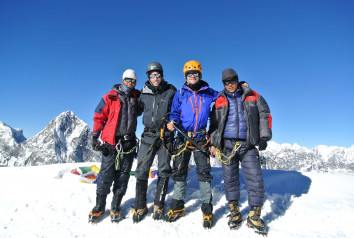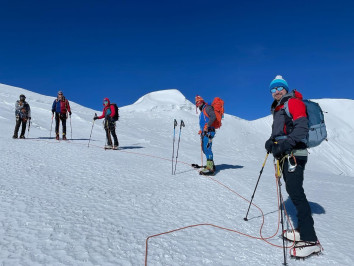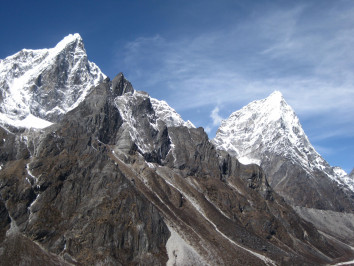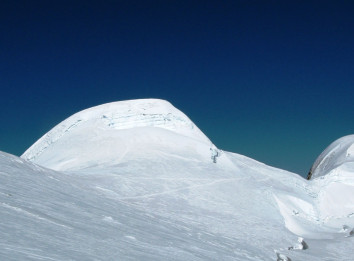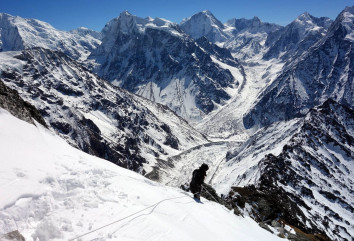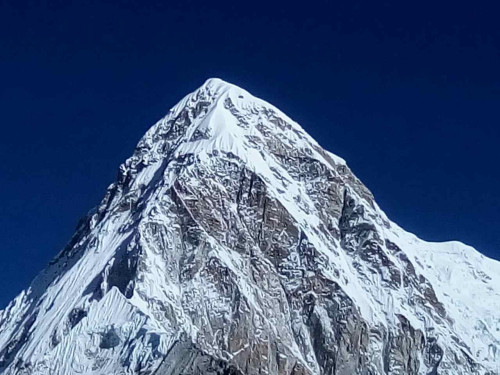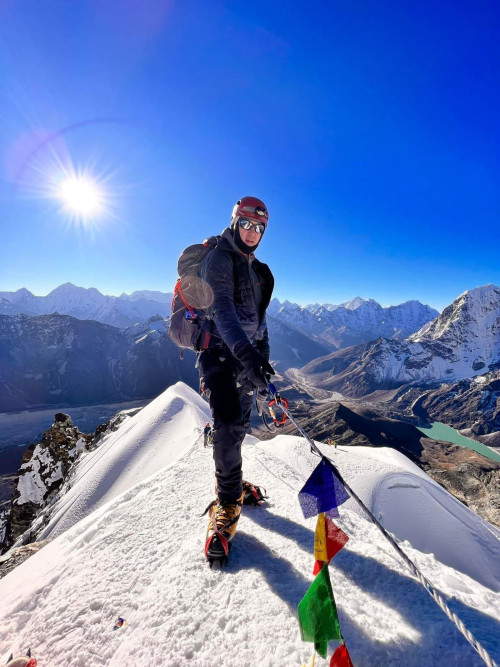Trip Highlights of Chulu East Peak Climbing
- Situated in the Annapurna region and a highly sought-out trekking peak by rookie climbers.
- An inspiring view of Annapurna (I, II, IV), Manaslu, Tilicho, Gangapurna, and other prominent peaks of the Annapurna range.
- Covers almost all major regions of the Annapurna Circuit region.
- Witnessing some wild animals like Himalayan Sheep, Snow Leopard, Ibexes, etc.
- Trekking and climbing for two weeks on rocky and snowy terrain.
- Witnessing Sherpa and Thakali cultures as we ascend our hike to Chame, Pisang, and other places en route.
- Climbing and trekking to Chulu East is a strenuous grade.
Chulu East Peak Climbing - Trip Overview
Chulu East at 6,584 metres, is a part of the Chulu mountain range. There are three mountains in this range, Chulu East, Chulu West at 6,429 metres, and Chulu Far East at 6,029 metres. Located to the North of the Annapurna range, Chulu Peak climbing has all thrills, stunning mountains, and a serene landscape.
Even with a technical climb of Chulu East Peak, trekkers admire this peak. The highly hiked arduous trek route to Pisang, Yak Kharka, Chulu East Base Camp, and the summit climb is ideal for intermediate climbers.
From North East Ridge, the first successful attempt was in 1955 by German expedition groups. They climbed to the summit of Chulu Far East Peak. Later in 1979, John Noble and Dick Isherwood summited Chulu East from Northeast Ridge.
The setting of the landscape around Chulu East peak is ideal for climbing. On the north of Marshyangdi River streaming down from Manang, Chulu East peak rises tall from Yak Kharka. The Manang Peak and Damodar Peak further make the setting utterly joyous. North of the Annapurna, it lies in the rain shadow area. This place receives low rain in a year. Thus, the conditions become ideal for Chulu East Peak Climbing in Summer. The strong wind here makes the stream of Glacial moraines into pillar-shaped structures.
Chulu East Peak Climbing - Itinerary Overview
To commence our 21 days long Chulu East Peak climbing and expedition, we'll head to Besisahar on a private jeep. The trek from here takes you to the pristine landscape of Annapurna Circuit. The wildlife and plants en route to the trail make the daytime hike joyous. Further, spotting some Himalayan animals would be a great moment. Around one week after hiking the Chulu East Peak Climbing expedition, we'll reach Kangla , from where we'll head to Chulu East Base Camp. Kangla Phedi, at 4,600 metres, is the best location for observing the sunrise. It gives a heavenly touch to the soul. Himlung Himal, Phu River, Nar Phu valley at 4,080 metres, Annapurna range on the horizon, it becomes the best hike in life.
We'll have a reserve day for AMS, tiredness, or bad weather. Our overnight stay will be in the tents at Chulu East Peak base camp.
From Chulu East Base Camp, we'll continue our return to Manang village. The rocky terrain now changes to a little vegetation. Barren landscapes of Yak Kharka and Kangla Phedi will be behind us as we continue hiking to Manang village. We'll hike to Tilicho Base Camp and successfully to Tilicho Lake. From Tilicho, we'll head to Dharamshala, Jomsom, Pokhara, and finally to Kathmandu. It marks our successful Chulu East Peak Climbing.
Chulu East Peak Climbing -Route
From the beginning of the Chulu East climb, climbers follow the Northeast Ridge to summit the peak. First, we'll make our way to Chulu East High Camp at 5,400 metres, which sits below Chulu Far East Peak at 6,059 meters. 3.7 km North of Chulu East base camp, the high centre of this peak sits at 22 degrees slope. The high centre or C1 rises to 900 metres tall. Here, we'll stay for a day acclimatising. If anyone from the group feels like staying for another day acclimatising, we'll arrange the summit accordingly.
The summit of Chulu East Peak is around 5 km from the high camp. To reach the Chulu East summit, you'll require climbing skills like crossing the avalanches and navigation on snow to reach the summit and back to base camp. The 450 metres below the summit ridge is a 45-degree steep climb. But, on average, the steepness of a 2km climb is around 30 degrees. The total distance you'll cover on the summit day is 12 km. Thus, technical expertise and endurance are a must for this expedition. The previous climbing experience becomes sharper as you apply them on this semi-technical peak. From Chulu East High Camp, we'll hike to the elevation of 1,400 metres and descend to the Base Camp by 2,300 metres down.
Chulu East Peak Climbing - Additional Info
Accommodations in Chulu East peak Climbing
Throughout the Chulu East Peak expedition, we'll follow tea house-based accommodation. You'll find the food items of your choice at tea houses en route. At most tea houses, a menu item includes Noodles, Soups, Rice, Spaghetti, etc. You can also inform us about diets and food allergies before we set for this expedition.
But, as we hike up to 5,000 metres, the services are not as good as those at 3,000 metres lodges. But, we'll try to make your accommodations at the best available tea house.
Our kitchen staff will prepare meals for the expedition team at Chulu East Peak Base Camp and High Camp. You'll get warm sleeping bags and nutritious meals while staying at these camps.
In Kathmandu, you'll have your stay at three-star hotels. Here, you'll get the luxury services on demand.
Best time for Chulu East Peak Climbing
Chulu East Peak Climbing is doable in Spring, Autumn, and Summer. This region lies behind the Annapurna range. Thus, rainfall is almost zero even during monsoon.
The clear sky, mild temperature, and best sightseeing make the days in Spring and Autumn best. Also, on the expedition, a stable temperature is crucial. Hence, the ideal conditions for stable temperature are from March-May and September-November.
Also, climbing a peak on fresh snow would be joyous. Thus, in Spring, the winter snow deposition makes the trekking and climbing fantastic.
Why World Expedition Nepal for Chulu East Peak Climbing?
World Expedition Nepal focuses on and promotes peak climbing and expeditions in Nepal. We have been providing tour services since 2017 by registered and licensed under Nepal Government. In the Annapurna Sanctuary region, we'll make sure that you'll have complete joy alongside the adventure of high-altitude climbing.
Our professional and experienced guides will ensure your utmost comfort and safety on Chulu East Peak climbing. We'll make this tour an unforgettable experience for you. Also, the health and safety of our clients is our primary motto. Our guides for these expeditions have mountain skills certification. They come with expertise in mountain medicine, first aid, and rescue operations.

 Recommended On
Recommended On
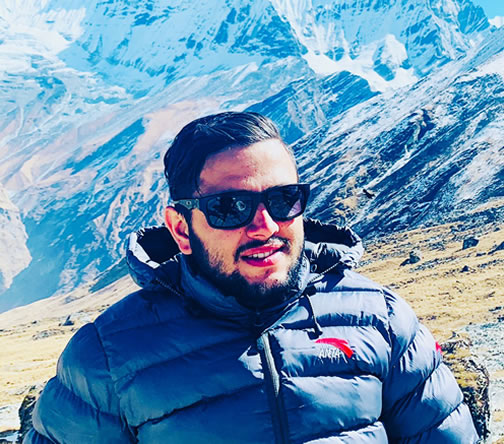



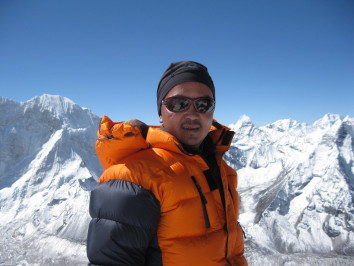
 6000m Peak Climbing , Nepal
6000m Peak Climbing , Nepal  29 Days
29 Days  US$3400
US$3400



-1.JPG)
